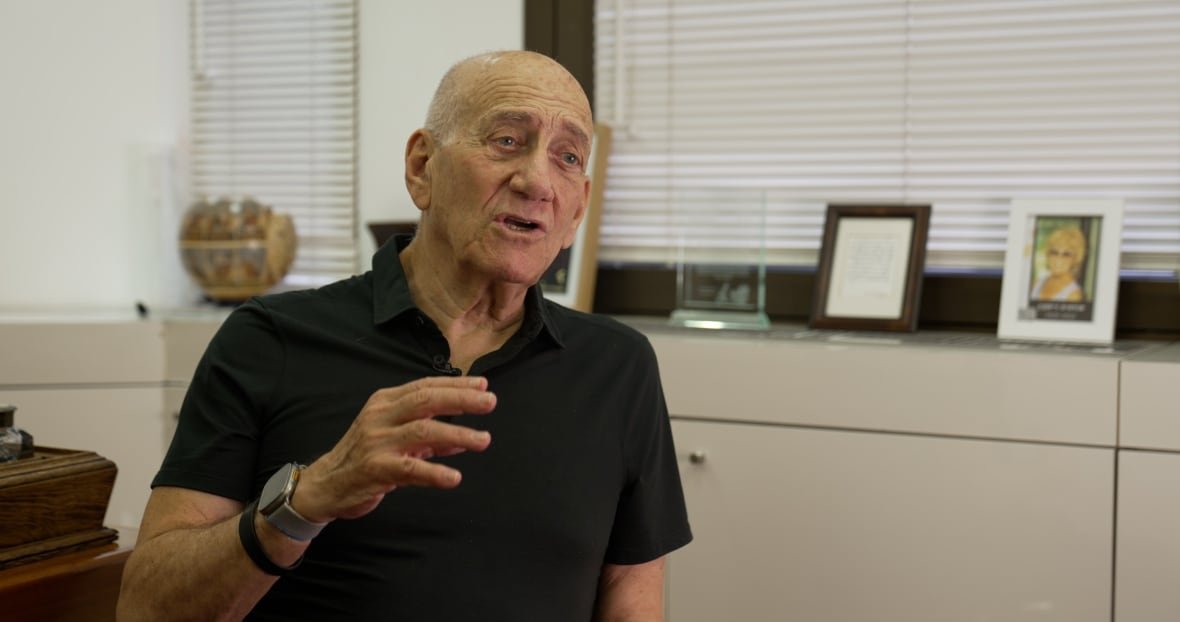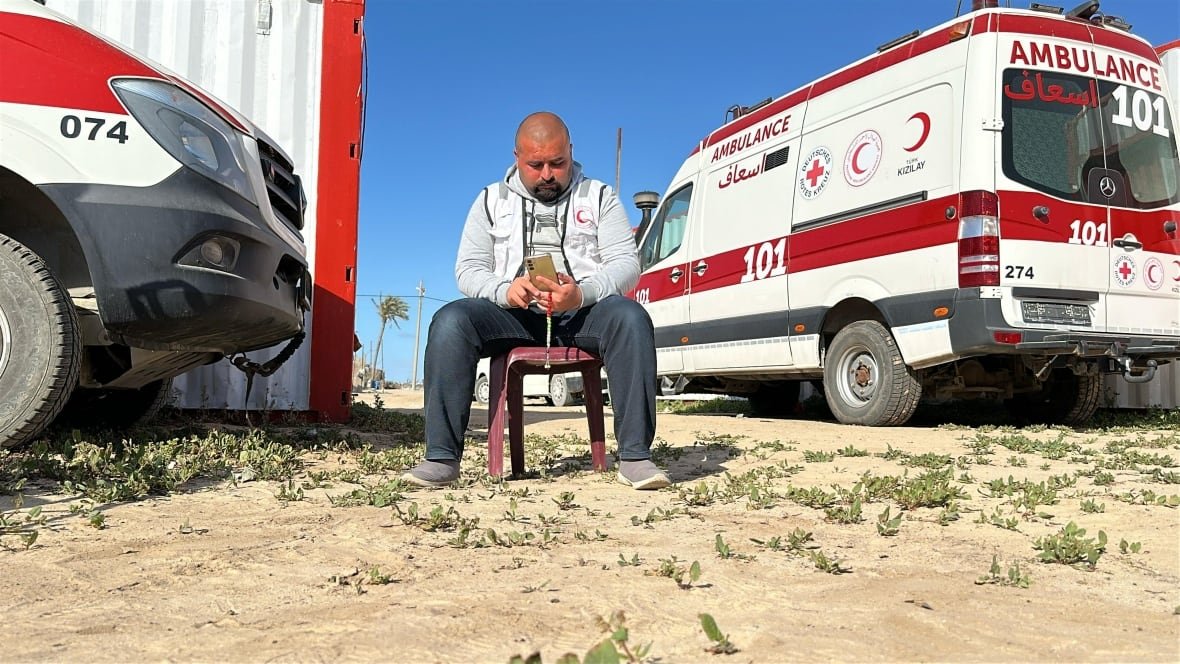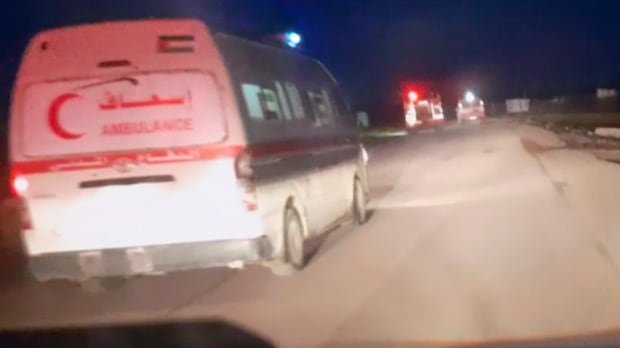There was fear in the voices of the Palestinian rescuers as their convoy moved along darkened roads near Rafah to the spot where they believed a team of their colleagues lay injured.
It was the night of March 23 and even for dangerous Gaza, those in the vehicles appeared to realize their rescue mission involved extreme peril.
“Those bastards — they’re only targeting our teams,” said Rifaat Radwan, a paramedic riding in one of the lead vehicles who turned on his phone’s camera. The full footage was later released by the Palestine Red Crescent Society.
Radwan’s team was headed to where the other group had been attacked a few hours earlier by Israel’s military.
By early morning, he and 14 others — all paramedics or aid workers, according to the United Nations — would be dead, their bodies buried in a mass grave alongside their crushed vehicles.
For more than a week and a half, the Israel Defence Forces (IDF) justified the attack, insisting there were numerous Hamas militants among the dead first responders and that their vehicles had been acting suspiciously and driving without emergency lights.
But Palestinian advocates say emerging video evidence — including video from Radwan’s phone, found at the scene of the incident — and eyewitness accounts suggest the Israeli version of events contained at best, glaring omissions, and at worst, outright lies about what happened that night.
Footage appears to show last moments
In Radwan’s video footage, parts of which were first released by the New York Times, the Palestinian Red Crescent workers in their vehicles are heard talking to each other about their anxiety, with one even reciting an end-of-life prayer, because they had been unable to contact the missing members of the previous rescue crew.
Recognizing the risk of an Israeli ambush, someone suggested forming up several ambulances in a line and ensuring all had their flashing emergency lights on to ensure the highest visibility.
But it wouldn’t make a difference. Seconds after the ambulance convoy stops next to a stricken vehicle on the side of the road, the arriving medics get hit with a hail of automatic weapons fire.
“They’ve surrounded us! They’re killing us!” one of the medics is heard screaming on the video.
Others are heard praying for their lives, including Radwan.
“Oh, Lord, accept me as a martyr and forgive me,” he said, as he uttered his final goodbyes to his mother.
There’s more gunfire, and then silence. It took a full week before a team from the United Nations was able to get access to the area and retrieve the bodies.
No explanation for initial misleading information
For more than 10 days after the attack and in multiple IDF briefings, officials insisted the Palestinian vehicles had been travelling without lights.
They also said that its ambush killed nine “terrorists,” without providing any direct evidence of their claims. Later, the IDF said six members of militant groups were among the dead, but again did not provide proof.
On Monday, at a news conference in Ramallah in the occupied West Bank, the Palestine Red Crescent Society, which had eight of its members killed in the attack, released the full 19 minutes of Radwan’s final video, with English subtitles. The video was found on Radwan’s phone, the organization said, which was recovered from his body more than a week later.
Following the full video’s release, Israeli government spokesperson David Mencer gave an updated account, elaborating on the IDF’s position.
“Whilst on a stakeout against terrorist activity, IDF soldiers opened fire from a distance at vehicles that were moving suspiciously in their direction,” Mencer said, again repeating that there were “terrorists” among the group.
“What were Hamas terrorists doing in ambulances?” he said.
A weekend turn
Then, over the weekend in a hastily called briefing, an Israeli military spokesperson, who spoke on the condition of anonymity, admitted the paramedics were “mistakenly” identified as a threat and said the military would investigate why.
In another social media post Monday, the IDF said its preliminary inquiry determined its troops fired due to a “perceived threat” and that the general staff fact-finding and assessment mechanism would probe deeper.
The Israeli military is changing its account of the killing of 15 Gaza emergency workers after a video published by the Palestine Red Crescent Society showed the medics in clearly marked emergency vehicles, with their lights on, being fired on by soldiers. Israel initially claimed soldiers had opened fire on vehicles that approached their position ‘suspiciously’ in the dark without lights or markings, contradicting the account of the only known survivor of the incident.
Neither statement, however, explained why the IDF initially released misleading information and only changed its story after the Radwan video was made public.
“We are asking the Israelis why they were killed,” said Younis Al-Khatib, the society’s president. “They were wearing their [safety] gear. The [ambulance] lights were on.
“Why did you destroy the ambulances after killing them? Why did you try to dig deep [in the sand] and hide the ambulances? Why did you hide the bodies?”
Israel’s former prime minister Ehud Olmert on Monday added his voice to a growing chorus of calls for an independent, external investigation. “It smells of a cover-up,” he said. A longtime foe of current prime minister Benjamin Netanyahu, Olmert told the BBC the Israeli military has much to explain.
“It looks bad, it smells bad and it disturbs me.”

In a briefing, an IDF spokesperson said the soldiers were not expecting the convoy to stop where it did on road and were surprised to see people getting out and running; later, he said it was approved procedure to bury bodies in mass graves to shield them from wild animals.
“There was no incident where the IDF tried to cover up. On the contrary, they called the UN immediately,” said the spokesperson. The IDF could not explain why the ambulances were also buried.
A lone survivor
Munther Jihad Abed, 27, the lone confirmed survivor of the attack, told CBC freelance videographer Mohamed El Saife that the IDF made no effort to verify at whom they were shooting.
“There was heavy gunfire directly on us, on our car,” he said in an interview near Khan Younis. “I didn’t hear a thing from my colleagues — not a sound, except for their final breaths. I saw death.”

At the Ramallah news conference, Red Crescent officials said the IDF soldiers deliberately chose not to confirm this, despite having numerous opportunities to do so.
“It wasn’t a single incident, it was multiple attacks,” said Red Crescent spokesperson Nebal Farsakh.
“It started with targeting the ambulance, which you can see [on the video] at the side of the road. Later, you see the moment of targeting the convoy of ambulances, and lastly the third attack was for the ambulance, the fourth ambulance, which came to support from the other side.”
‘This phase of the war is less popular’
Israel has been repeatedly accused of indiscriminately targeting Palestinian civilians in Gaza over the last 18 months of war in the territory.
In one of the deadliest incidents, in February 2025, the IDF killed 112 people waiting in a line up for flour in Gaza City. Around the same time, a panel of UN experts condemned repeated Israeli “massacres,” including attacks on humanitarian aid convoys.
Israeli human rights group Yesh Din reported last July that of more than 664 complaints made into the conduct of Israel’s military over a 10-year period, only six per cent led to an investigation and just one ended in an indictment.
The group concluded the military’s own assessment procedure used for such investigations “refrains from conducting a proper and effective assessment.”
While the mass death of Palestinian civilians has generated intense international outrage, particularly from humanitarian groups, within Israel, criticism of the IDF and its practices has generally been muted.
Longtime activist Sarit Michaeli, with the Israeli human rights group B’Tselem, says the deadly incident with the paramedics may be a greater test of transparency for the IDF.
“This phase of the war is less popular,” she told CBC News in an interview.
“I think many Israelis understand that military action is not going to bring the hostages back alive. And because more people are willing to criticize the justification of this war, people are willing to be a bit more critical of things that happen within the war, and the killing of the paramedics is one of those things.”
Whether that means there will be repercussions however, is another issue, says Michaeli.
U.S. President Donald Trump has endorsed Israel’s military campaign in Gaza and made his own attempts to undermine the work of the International Criminal Court, a possible international mechanism to investigate the paramedics’ deaths.
Last year, after the ICC issued an arrest warrant for Netanyahu, Trump sanctioned the court and its lead prosecutor.
“It doesn’t look like the International Criminal Court has immense clout right now that it can use to investigate or prosecute this case,” said Michaeli.

